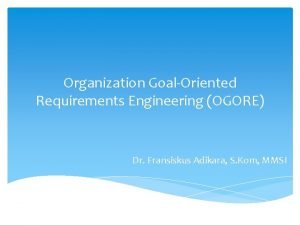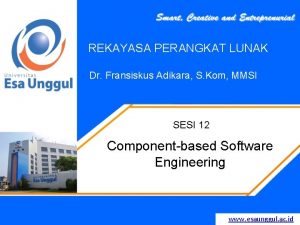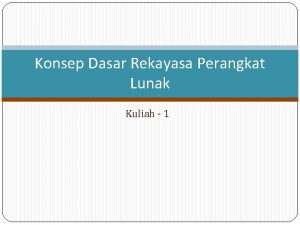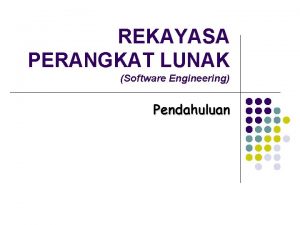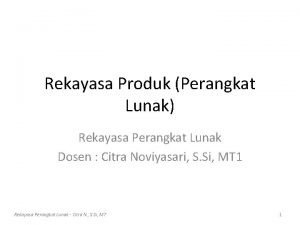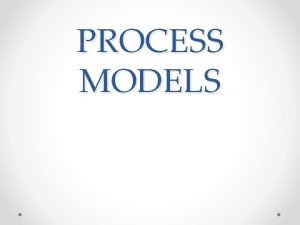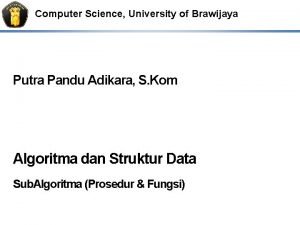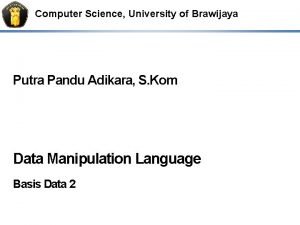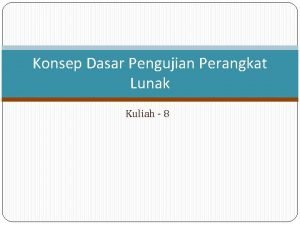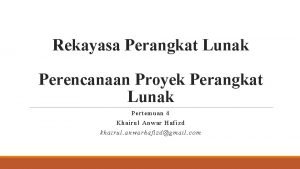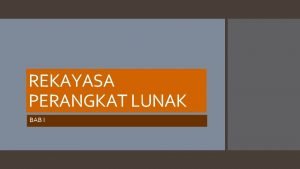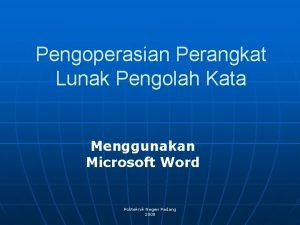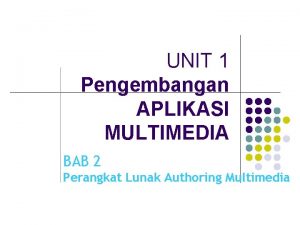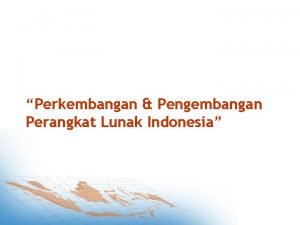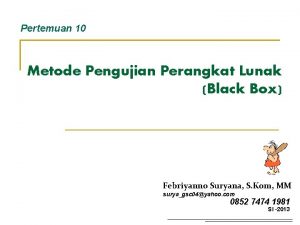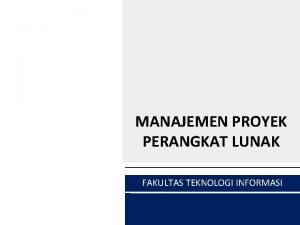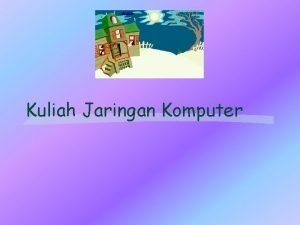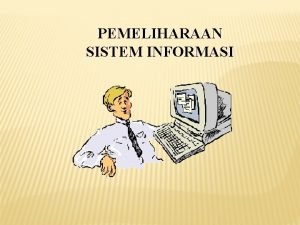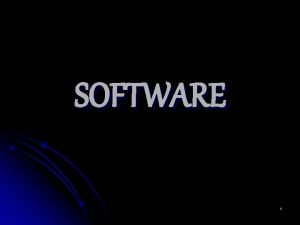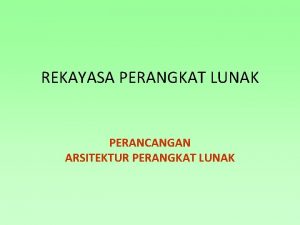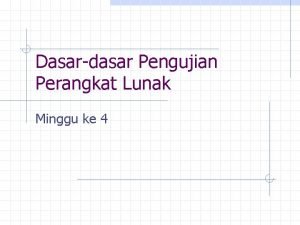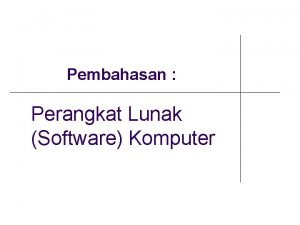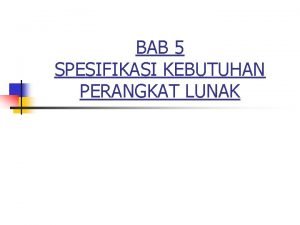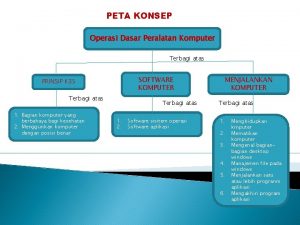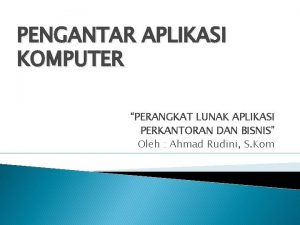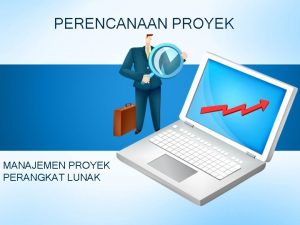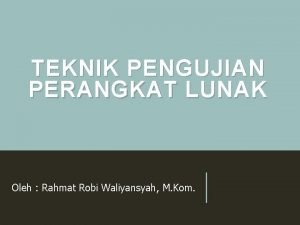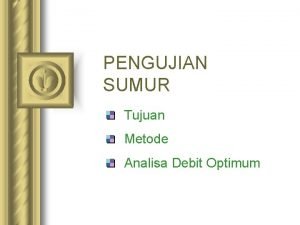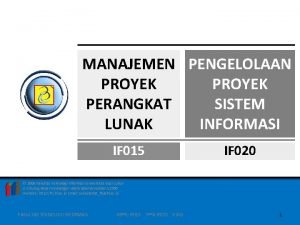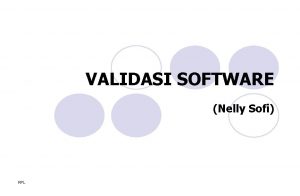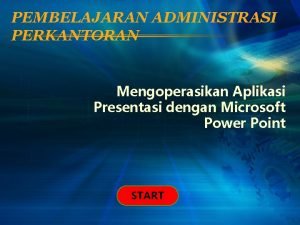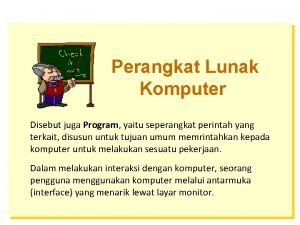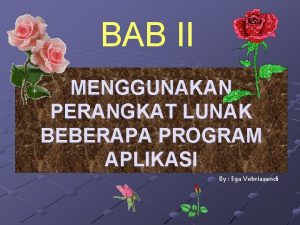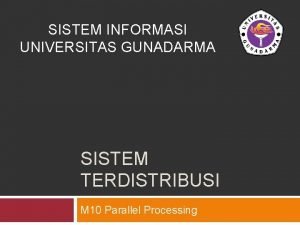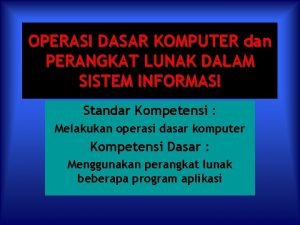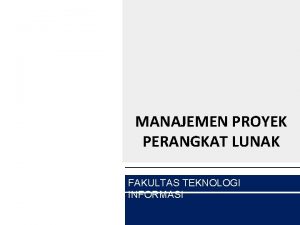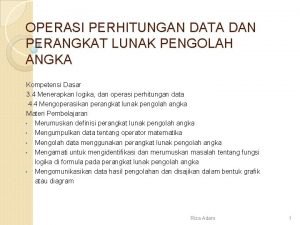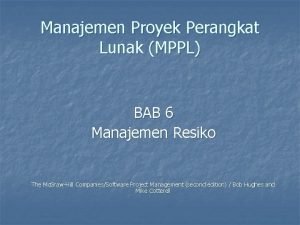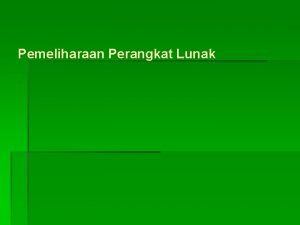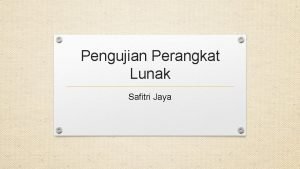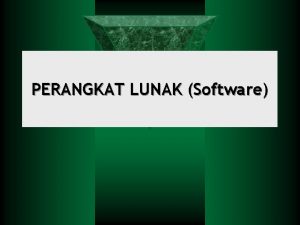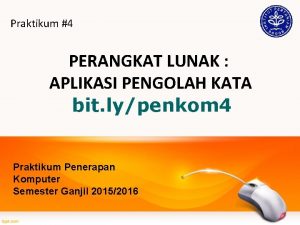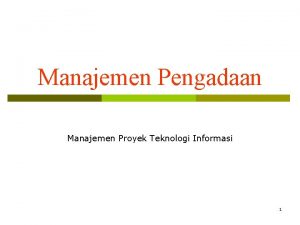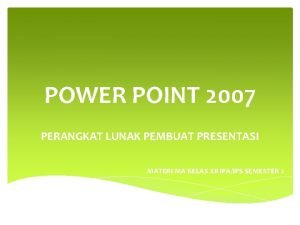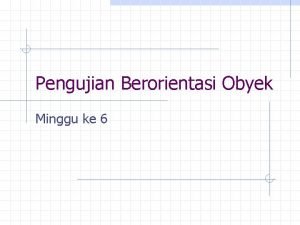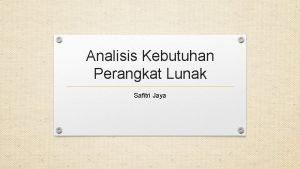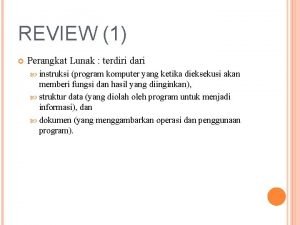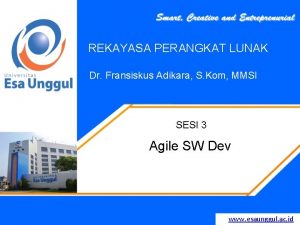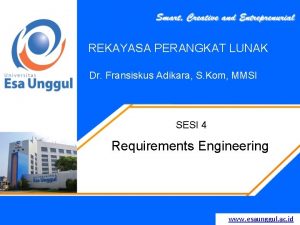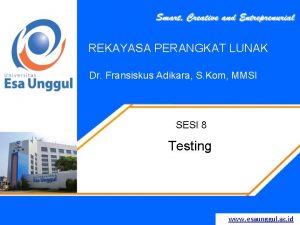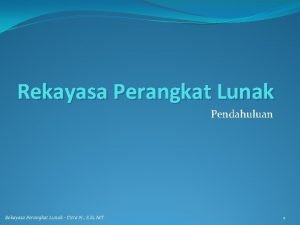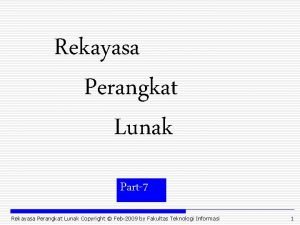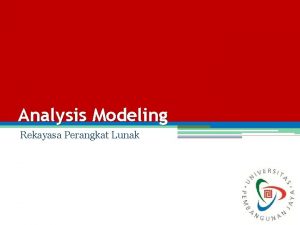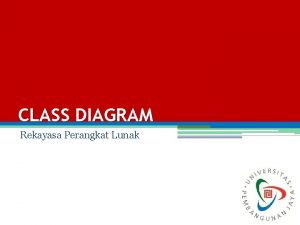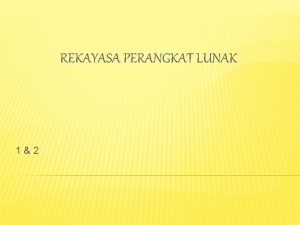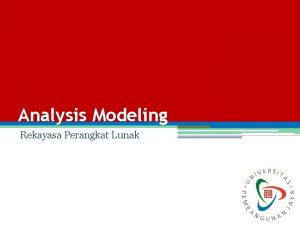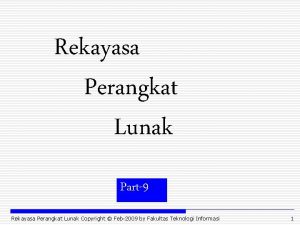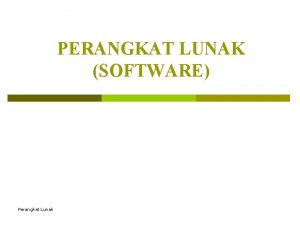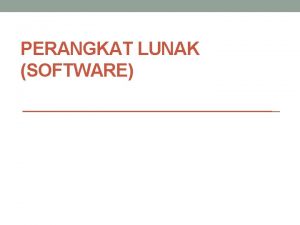REKAYASA PERANGKAT LUNAK Dr Fransiskus Adikara S Kom





























































- Slides: 61

REKAYASA PERANGKAT LUNAK Dr. Fransiskus Adikara, S. Kom, MMSI SESI 1 Kontrak Perkuliahan dan Pengantar www. esaunggul. ac. id

VISI Menjadi perguruan tinggi kelas dunia berbasis intelektualitas, kreatifitas dan kewirausahaan, yang unggul dalam mutu pengelolaan dan hasil pelaksanaan Tridarma Perguruan Tinggi. MISI 1. Menyelenggarakan pendidikan tinggi yang bermutu dan relevan 2. Menciptakan suasana akademik yang kondusif 3. Memberikan pelayanan prima kepada seluruh pemangku kepentingan www. esaunggul. ac. id

TOPIK SEBELUM UTS 1. 2. 3. 4. 5. 6. 7. Topik 1 – Pengantar Topik 2 – Software Process Topik 3 – Agile SW Dev Topik 4 – Requirements Engineering Topik 5 – System Modeling - 1 Topik 6 – System Modeling - 2 Topik 7 - Implementation www. esaunggul. ac. id

TOPIK SETELAH UTS 8. 9. 10. 11. 12. 13. 14. Topik 08 - Testing Topik 09 - Evolution Topik 10 – Software Reuse - 1 Topik 11 – Software Reuse - 2 Topik 12 – Component-based SE Topik 13 – Sytems Engineering 1 Topik 14 – System Engineering 2 www. esaunggul. ac. id

5 C 3 h 0 /a p 1 t 0 /e r 2 0 1 4 I n t r o d u c t i o n Topics covered • Professional software development – What is meant by software engineering. • Software engineering ethics – A brief introduction to ethical issues that affect software engineering. • Case studies – An introduction to three examples that are used in later chapters in the book. www. esaunggul. ac. id

6 C 3 h 0 /a p 1 t 0 /e r 2 0 1 4 I n t r o d u c t i o n Software engineering • The economies of ALL developed nations are dependent on software. • More and more systems are software controlled • Software engineering is concerned with theories, methods and tools for professional software development. • Expenditure on software represents a significant fraction of GNP in all developed countries. www. esaunggul. ac. id

7 C 3 h 0 /a p 1 t 0 /e r 2 0 1 4 I n t r o d u c t i o n Software costs • Software costs often dominate computer system costs. The costs of software on a PC are often greater than the hardware cost. • Software costs more to maintain than it does to develop. For systems with a long life, maintenance costs may be several times development costs. • Software engineering is concerned with costeffective software development. www. esaunggul. ac. id

8 C 3 h 0 /a p 1 t 0 /e r 2 0 1 4 I n t r o d u c t i o n Software project failure • Increasing system complexity – As new software engineering techniques help us to build larger, more complex systems, the demands change. Systems have to be built and delivered more quickly; larger, even more complex systems are required; systems have to have new capabilities that were previously thought to be impossible. • Failure to use software engineering methods – It is fairly easy to write computer programs without using software engineering methods and www. esaunggul. ac. id

9 C 3 h 0 /a p 1 t 0 /e r 2 0 1 4 I n t r o d u c t i o n Professional software development www. esaunggul. ac. id

1 C 3 h 0 /a p 1 t 0 /e r 2 0 1 4 I n t r o d u c t i o n Frequently asked questions about software engineering Question Answer What is software? Computer programs and associated documentation. Software products may be developed for a particular customer or may be developed for a general market. What are the attributes of good software? Good software should deliver the required functionality and performance to the user and should be maintainable, dependable and usable. What is software engineering? Software engineering is an engineering discipline that is concerned with all aspects of software production. What are the fundamental software engineering activities? Software specification, software development, software validation and software evolution. What is the difference between software engineering and computer science? Computer science focuses on theory and fundamentals; software engineering is concerned with the practicalities of developing and delivering useful software. What is the difference between software engineering and system engineering? System engineering is concerned with all aspects of computer-based systems development including hardware, software and process engineering. Software engineering is part of this more general process. www. esaunggul. ac. id

1 C 3 h 0 1 /a p 1 t 0 /e r 2 0 1 4 I n t r o d u c t i o n Frequently asked questions about software engineering Question Answer What are the key challenges facing software engineering? Coping with increasing diversity, demands for reduced delivery times and developing trustworthy software. What are the engineering? software Roughly 60% of software costs are development costs, 40% are testing costs. For custom software, evolution costs often exceed development costs. What are the best software engineering techniques and methods? While all software projects have to be professionally managed and developed, different techniques are appropriate for different types of system. For example, games should always be developed using a series of prototypes whereas safety critical control systems require a complete and analyzable specification to be developed. You can’t, therefore, say that one method is better than another. What differences has the web made to software engineering? The web has led to the availability of software services and the possibility of developing highly distributed servicebased systems. Web-based systems development has led to important advances in programming languages and software reuse. costs of www. esaunggul. ac. id

1 C 3 h 0 2 /a p 1 t 0 /e r 2 0 1 4 I n t r o d u c t i o n Software products • Generic products – Stand-alone systems that are marketed and sold to any customer who wishes to buy them. – Examples – PC software such as graphics programs, project management tools; CAD software; software for specific markets such as appointments systems for dentists. • Customized products – Software that is commissioned by a specific customer to meet their own needs. – Examples – embedded control systems, www. esaunggul. ac. id air traffic

1 C 3 h 0 3 /a p 1 t 0 /e r 2 0 1 4 I n t r o d u c t i o n Product specification • Generic products – The specification of what the software should do is owned by the software developer and decisions on software change are made by the developer. • Customized products – The specification of what the software should do is owned by the customer for the software and they make decisions on software changes that are required. www. esaunggul. ac. id

1 C 3 h 0 4 /a p 1 t 0 /e r 2 0 1 4 I n t r o d u c t i o n Essential attributes of good software Product characteristic Description Maintainability Software should be written in such a way so that it can evolve to meet the changing needs of customers. This is a critical attribute because software change is an inevitable requirement of a changing business environment. Dependability and security Software dependability includes a range of characteristics including reliability, security and safety. Dependable software should not cause physical or economic damage in the event of system failure. Malicious users should not be able to access or damage the system. Efficiency Software should not make wasteful use of system resources such as memory and processor cycles. Efficiency therefore includes responsiveness, processing time, memory utilisation, etc. Acceptability Software must be acceptable to the type of users for which it is designed. This means that it must be understandable, usable and compatible with other systems that they use. www. esaunggul. ac. id

1 C 3 h 0 5 /a p 1 t 0 /e r 2 0 1 4 I n t r o d u c t i o n Software engineering • Software engineering is an engineering discipline that is concerned with all aspects of software production from the early stages of system specification through to maintaining the system after it has gone into use. • Engineering discipline – Using appropriate theories and methods to solve problems bearing in mind organizational and financial constraints. • All aspects of software production – Not just technical process of development. Also www. esaunggul. ac. id

1 C 3 h 0 6 /a p 1 t 0 /e r 2 0 1 4 I n t r o d u c t i o n Importance of software engineering • More and more, individuals and society rely on advanced software systems. We need to be able to produce reliable and trustworthy systems economically and quickly. • It is usually cheaper, in the long run, to use software engineering methods and techniques for software systems rather than just write the programs as if it was a personal programming project. For most types of system, the majority of costs are the costs of changing the software after it has gone into use. www. esaunggul. ac. id

1 C 3 h 0 7 /a p 1 t 0 /e r 2 0 1 4 I n t r o d u c t i o n Software process activities • Software specification, where customers and engineers define the software that is to be produced and the constraints on its operation. • Software development, where the software is designed and programmed. • Software validation, where the software is checked to ensure that it is what the customer requires. • Software evolution, where the software is modified to reflect changing customer and market requirements. www. esaunggul. ac. id

1 C 3 h 0 8 /a p 1 t 0 /e r 2 0 1 4 I n t r o d u c t i o n General issues that affect software • Heterogeneity – Increasingly, systems are required to operate as distributed systems across networks that include different types of computer and mobile devices. • Business and social change – Business and society are changing incredibly quickly as emerging economies develop and new technologies become available. They need to be able to change their existing software and to rapidly develop new software. www. esaunggul. ac. id

1 C 3 h 0 9 /a p 1 t 0 /e r 2 0 1 4 I n t r o d u c t i o n General issues that affect software • Security and trust – As software is intertwined with all aspects of our lives, it is essential that we can trust that software. • Scale – Software has to be developed across a very wide range of scales, from very small embedded systems in portable or wearable devices through to Internet-scale, cloud-based systems that serve a global community. www. esaunggul. ac. id

2 C 3 h 0 /a p 1 t 0 /e r 2 0 1 4 I n t r o d u c t i o n Software engineering diversity • There are many different types of software system and there is no universal set of software techniques that is applicable to all of these. • The software engineering methods and tools used depend on the type of application being developed, the requirements of the customer and the background of the development team. www. esaunggul. ac. id

2 C 3 h 0 1 /a p 1 t 0 /e r 2 0 1 4 I n t r o d u c t i o n Application types • Stand-alone applications – These are application systems that run on a local computer, such as a PC. They include all necessary functionality and do not need to be connected to a network. • Interactive transaction-based applications – Applications that execute on a remote computer and are accessed by users from their own PCs or terminals. These include web applications such as e-commerce applications. • Embedded control systems www. esaunggul. ac. id

2 C 3 h 0 2 /a p 1 t 0 /e r 2 0 1 4 I n t r o d u c t i o n Application types • Batch processing systems – These are business systems that are designed to process data in large batches. They process large numbers of individual inputs to create corresponding outputs. • Entertainment systems – These are systems that are primarily for personal use and which are intended to entertain the user. • Systems for modeling and simulation – These are systems that are developed by scientists and engineers to model physical processes or www. esaunggul. ac. id

2 C 3 h 0 3 /a p 1 t 0 /e r 2 0 1 4 I n t r o d u c t i o n Application types • Data collection systems – These are systems that collect data from their environment using a set of sensors and send that data to other systems for processing. • Systems of systems – These are systems that are composed of a number of other software systems. www. esaunggul. ac. id

2 C 3 h 0 4 /a p 1 t 0 /e r 2 0 1 4 I n t r o d u c t i o n Software engineering fundamentals • Some fundamental principles apply to all types of software system, irrespective of the development techniques used: – Systems should be developed using a managed and understood development process. Of course, different processes are used for different types of software. – Dependability and performance are important for all types of system. – Understanding and managing the software specification and requirements (what the software www. esaunggul. ac. id

2 C 3 h 0 5 /a p 1 t 0 /e r 2 0 1 4 I n t r o d u c t i o n Internet software engineering • The Web is now a platform for running application and organizations are increasingly developing webbased systems rather than local systems. • Web services (discussed in Chapter 19) allow application functionality to be accessed over the web. • Cloud computing is an approach to the provision of computer services where applications run remotely on the ‘cloud’. – Users do not buy software buy pay according to use. www. esaunggul. ac. id

2 C 3 h 0 6 /a p 1 t 0 /e r 2 0 1 4 I n t r o d u c t i o n Web-based software engineering • Web-based systems are complex distributed systems but the fundamental principles of software engineering discussed previously are as applicable to them as they are to any other types of system. • The fundamental ideas of software engineering apply to web-based software in the same way that they apply to other types of software system. www. esaunggul. ac. id

2 C 3 h 0 7 /a p 1 t 0 /e r 2 0 1 4 I n t r o d u c t i o n Web software engineering • Software reuse – Software reuse is the dominant approach for constructing web-based systems. When building these systems, you think about how you can assemble them from pre-existing software components and systems. • Incremental and agile development – Web-based systems should be developed and delivered incrementally. It is now generally recognized that it is impractical to specify all the requirements for such systems in advance. www. esaunggul. ac. id

2 C 3 h 0 8 /a p 1 t 0 /e r 2 0 1 4 I n t r o d u c t i o n Web software engineering • Service-oriented systems – Software may be implemented using serviceoriented software engineering, where the software components are stand-alone web services. • Rich interfaces – Interface development technologies such as AJAX and HTML 5 have emerged that support the creation of rich interfaces within a web browser. www. esaunggul. ac. id

2 C 3 h 0 9 /a p 1 t 0 /e r 2 0 1 4 I n t r o d u c t i o n Software engineering ethics www. esaunggul. ac. id

C 3 h 0 /a p 1 t 0 /e r 2 0 1 4 I n t r o d u c t i o n Software engineering ethics • Software engineering involves wider responsibilities than simply the application of technical skills. • Software engineers must behave in an honest and ethically responsible way if they are to be respected as professionals. • Ethical behaviour is more than simply upholding the law but involves following a set of principles that are morally correct. www. esaunggul. ac. id

C 3 h 0 1 /a p 1 t 0 /e r 2 0 1 4 I n t r o d u c t i o n Issues of professional responsibility • Confidentiality – Engineers should normally respect the confidentiality of their employers or clients irrespective of whether or not a formal confidentiality agreement has been signed. • Competence – Engineers should not misrepresent their level of competence. They should not knowingly accept work which is outwith their competence. www. esaunggul. ac. id

C 3 h 0 2 /a p 1 t 0 /e r 2 0 1 4 I n t r o d u c t i o n Issues of professional responsibility • Intellectual property rights – Engineers should be aware of local laws governing the use of intellectual property such as patents, copyright, etc. They should be careful to ensure that the intellectual property of employers and clients is protected. • Computer misuse – Software engineers should not use their technical skills to misuse other people’s computers. Computer misuse ranges from relatively trivial (game playing on an employer’s machine, say) to extremely serious (dissemination of viruses). www. esaunggul. ac. id

C 3 h 0 3 /a p 1 t 0 /e r 2 0 1 4 I n t r o d u c t i o n ACM/IEEE Code of Ethics • The professional societies in the US have cooperated to produce a code of ethical practice. • Members of these organisations sign up to the code of practice when they join. • The Code contains eight Principles related to the behaviour of and decisions made by professional software engineers, including practitioners, educators, managers, supervisors and policy makers, as well as trainees and students of the profession. www. esaunggul. ac. id

C 3 h 0 4 /a p 1 t 0 /e r 2 0 1 4 I n t r o d u c t i o n Rationale for the code of ethics – Computers have a central and growing role in commerce, industry, government, medicine, education, entertainment and society at large. Software engineers are those who contribute by direct participation or by teaching, to the analysis, specification, design, development, certification, maintenance and testing of software systems. – Because of their roles in developing software systems, software engineers have significant opportunities to do good or cause harm, to enable others to do good or cause harm, or to influence www. esaunggul. ac. id others to do good or cause harm. To ensure, as

C 3 h 0 5 /a p 1 t 0 /e r 2 0 1 4 I n t r o d u c t i o n The ACM/IEEE Code of Ethics Software Engineering Code of Ethics and Professional Practice ACM/IEEE-CS Joint Task Force on Software Engineering Ethics and Professional Practices PREAMBLE The short version of the code summarizes aspirations at a high level of the abstraction; the clauses that are included in the full version give examples and details of how these aspirations change the way we act as software engineering professionals. Without the aspirations, the details can become legalistic and tedious; without the details, the aspirations can become high sounding but empty; together, the aspirations and the details form a cohesive code. Software engineers shall commit themselves to making the analysis, specification, design, development, testing and maintenance of software a beneficial and respected profession. In accordance with their commitment to the health, safety and welfare of the public, software engineers shall adhere to the following Eight Principles: www. esaunggul. ac. id

C 3 h 0 6 /a p 1 t 0 /e r 2 0 1 4 I n t r o d u c t i o n Ethical principles 1. PUBLIC - Software engineers shall act consistently with the public interest. 2. CLIENT AND EMPLOYER - Software engineers shall act in a manner that is in the best interests of their client and employer consistent with the public interest. 3. PRODUCT - Software engineers shall ensure that their products and related modifications meet the highest professional standards possible. 4. JUDGMENT - Software engineers shall maintain integrity and independence in their professional judgment. 5. MANAGEMENT - Software engineering managers and leaders shall subscribe to and promote an ethical approach to the management of software development and maintenance. 6. PROFESSION - Software engineers shall advance the integrity and reputation of the profession consistent with the public interest. 7. COLLEAGUES - Software engineers shall be fair to and supportive of their colleagues. 8. SELF - Software engineers shall participate in lifelong learning regarding the practice of their profession and shall promote an ethical approach to the practice of the profession. www. esaunggul. ac. id

C 3 h 0 7 /a p 1 t 0 /e r 2 0 1 4 I n t r o d u c t i o n Case studies www. esaunggul. ac. id

C 3 h 0 8 /a p 1 t 0 /e r 2 0 1 4 I n t r o d u c t i o n Ethical dilemmas • Disagreement in principle with the policies of senior management. • Your employer acts in an unethical way and releases a safety-critical system without finishing the testing of the system. • Participation in the development of military weapons systems or nuclear systems. www. esaunggul. ac. id

C 3 h 0 9 /a p 1 t 0 /e r 2 0 1 4 I n t r o d u c t i o n Case studies • A personal insulin pump – An embedded system in an insulin pump used by diabetics to maintain blood glucose control. • A mental health case patient management system – Mentcare. A system used to maintain records of people receiving care for mental health problems. • A wilderness weather station – A data collection system that collects data about weather conditions in remote areas. • i. Learn: a digital learning environment – A system to support learning in schools www. esaunggul. ac. id

4 C 3 h 0 /a p 1 t 0 /e r 2 0 1 4 I n t r o d u c t i o n Insulin pump control system • Collects data from a blood sugar sensor and calculates the amount of insulin required to be injected. • Calculation based on the rate of change of blood sugar levels. • Sends signals to a micro-pump to deliver the correct dose of insulin. • Safety-critical system as low blood sugars can lead to brain malfunctioning, coma and death; highblood sugar levels have long-term consequences such as eye and kidney damage. www. esaunggul. ac. id

4 C 3 h 0 1 /a p 1 t 0 /e r 2 0 1 4 I n t r o d u c t i o n Insulin pump hardware architecture www. esaunggul. ac. id

4 C 3 h 0 2 /a p 1 t 0 /e r 2 0 1 4 I n t r o d u c t i o n Activity model of the insulin pump www. esaunggul. ac. id

4 C 3 h 0 3 /a p 1 t 0 /e r 2 0 1 4 I n t r o d u c t i o n Essential high-level requirements • The system shall be available to deliver insulin when required. • The system shall perform reliably and deliver the correct amount of insulin to counteract the current level of blood sugar. • The system must therefore be designed and implemented to ensure that the system always meets these requirements. www. esaunggul. ac. id

4 C 3 h 0 4 /a p 1 t 0 /e r 2 0 1 4 I n t r o d u c t i o n Mentcare: A patient information system for mental health care • A patient information system to support mental health care is a medical information system that maintains information about patients suffering from mental health problems and the treatments that they have received. • Most mental health patients do not require dedicated hospital treatment but need to attend specialist clinics regularly where they can meet a doctor who has detailed knowledge of their problems. • To make it easier for patients to attend, these clinics www. esaunggul. ac. id are not just run in hospitals. They may also be held

4 C 3 h 0 5 /a p 1 t 0 /e r 2 0 1 4 I n t r o d u c t i o n Mentcare • Mentcare is an information system that is intended for use in clinics. • It makes use of a centralized database of patient information but has also been designed to run on a PC, so that it may be accessed and used from sites that do not have secure network connectivity. • When the local systems have secure network access, they use patient information in the database but they can download and use local copies of patient records when they are disconnected. www. esaunggul. ac. id

4 C 3 h 0 6 /a p 1 t 0 /e r 2 0 1 4 I n t r o d u c t i o n Mentcare goals • To generate management information that allows health service managers to assess performance against local and government targets. • To provide medical staff with timely information to support the treatment of patients. www. esaunggul. ac. id

4 C 3 h 0 7 /a p 1 t 0 /e r 2 0 1 4 I n t r o d u c t i o n The organization of the Mentcare system www. esaunggul. ac. id

4 C 3 h 0 8 /a p 1 t 0 /e r 2 0 1 4 I n t r o d u c t i o n Key features of the Mentcare system • Individual care management – Clinicians can create records for patients, edit the information in the system, view patient history, etc. The system supports data summaries so that doctors can quickly learn about the key problems and treatments that have been prescribed. • Patient monitoring – The system monitors the records of patients that are involved in treatment and issues warnings if possible problems are detected. • Administrative reporting www. esaunggul. ac. id

4 C 3 h 0 9 /a p 1 t 0 /e r 2 0 1 4 I n t r o d u c t i o n Mentcare system concerns • Privacy – It is essential that patient information is confidential and is never disclosed to anyone apart from authorised medical staff and the patient themselves. • Safety – Some mental illnesses cause patients to become suicidal or a danger to other people. Wherever possible, the system should warn medical staff about potentially suicidal or dangerous patients. – The system must be available when needed www. esaunggul. ac. id

5 C 3 h 0 /a p 1 t 0 /e r 2 0 1 4 I n t r o d u c t i o n Wilderness weather station • The government of a country with large areas of wilderness decides to deploy several hundred weather stations in remote areas. • Weather stations collect data from a set of instruments that measure temperature and pressure, sunshine, rainfall, wind speed and wind direction. – The weather station includes a number of instruments that measure weather parameters such as the wind speed and direction, the ground air temperatures, the barometric pressure www. esaunggul. ac. id and the rainfall over a 24 -hour period. Each of

5 C 3 h 0 1 /a p 1 t 0 /e r 2 0 1 4 I n t r o d u c t i o n The weather station’s environment www. esaunggul. ac. id

5 C 3 h 0 2 /a p 1 t 0 /e r 2 0 1 4 I n t r o d u c t i o n Weather information system The weather station system – This is responsible for collecting weather data, carrying out some initial data processing and transmitting it to the data management system. • The data management and archiving system – This system collects the data from all of the wilderness weather stations, carries out data processing and analysis and archives the data. • The station maintenance system – This system can communicate by satellite with all wilderness weather stations to monitor the health of www. esaunggul. ac. id •

5 C 3 h 0 3 /a p 1 t 0 /e r 2 0 1 4 I n t r o d u c t i o n Additional software functionality • Monitor the instruments, power and communication hardware and report faults to the management system. • Manage the system power, ensuring that batteries are charged whenever the environmental conditions permit but also that generators are shut down in potentially damaging weather conditions, such as high wind. • Support dynamic reconfiguration where parts of the software replaced with new versions and where backup instruments are switched into the system in www. esaunggul. ac. id the event of system failure.

5 C 3 h 0 4 /a p 1 t 0 /e r 2 0 1 4 I n t r o d u c t i o n i. Learn: A digital learning environment • A digital learning environment is a framework in which a set of general-purpose and specially designed tools for learning may be embedded plus a set of applications that are geared to the needs of the learners using the system. • The tools included in each version of the environment are chosen by teachers and learners to suit their specific needs. – These can be general applications such as spreadsheets, learning management applications such as a Virtual Learning Environment (VLE) to www. esaunggul. ac. id manage homework submission and assessment,

5 C 3 h 0 5 /a p 1 t 0 /e r 2 0 1 4 I n t r o d u c t i o n Service-oriented systems • The system is a service-oriented system with all system components considered to be a replaceable service. • This allows the system to be updated incrementally as new services become available. • It also makes it possible to rapidly configure the system to create versions of the environment for different groups such as very young children who cannot read, senior students, etc. www. esaunggul. ac. id

5 C 3 h 0 6 /a p 1 t 0 /e r 2 0 1 4 I n t r o d u c t i o n i. Learn services • Utility services that provide basic applicationindependent functionality and which may be used by other services in the system. • Application services that provide specific applications such as email, conferencing, photo sharing etc. and access to specific educational content such as scientific films or historical resources. • Configuration services that are used to adapt the environment with a specific set of application services and do define how services are shared www. esaunggul. ac. id between students, teachers and their parents.

5 C 3 h 0 7 /a p 1 t 0 /e r 2 0 1 4 I n t r o d u c t i o n i. Learn architecture www. esaunggul. ac. id

5 C 3 h 0 8 /a p 1 t 0 /e r 2 0 1 4 I n t r o d u c t i o n i. Learn service integration • Integrated services are services which offer an API (application programming interface) and which can be accessed by other services through that API. Direct service-to-service communication is therefore possible. • Independent services are services which are simply accessed through a browser interface and which operate independently of other services. Information can only be shared with other services through explicit user actions such as copy and paste; re-authentication may be required for each www. esaunggul. ac. id independent service.

5 C 3 h 0 9 /a p 1 t 0 /e r 2 0 1 4 I n t r o d u c t i o n Key points • Software engineering is an engineering discipline that is concerned with all aspects of software production. • Essential software product attributes are maintainability, dependability and security, efficiency and acceptability. • The high-level activities of specification, development, validation and evolution are part of all software processes. • The fundamental notions of software engineering are universally applicable to all types of system www. esaunggul. ac. id

6 C 3 h 0 /a p 1 t 0 /e r 2 0 1 4 I n t r o d u c t i o n Key points • There are many different types of system and each requires appropriate software engineering tools and techniques for their development. • The fundamental ideas of software engineering are applicable to all types of software system. • Software engineers have responsibilities to the engineering profession and society. They should not simply be concerned with technical issues. • Professional societies publish codes of conduct which set out the standards of behaviour expected of their members. www. esaunggul. ac. id

Terima kasih www. esaunggul. ac. id
 Ogore
Ogore Fransiskus adikara
Fransiskus adikara Konsep rpl
Konsep rpl Rekayasa perangkat lunak
Rekayasa perangkat lunak Kegiatan pada rekayasa kebutuhan
Kegiatan pada rekayasa kebutuhan Definisi rekayasa perangkat lunak
Definisi rekayasa perangkat lunak Lapisan rekayasa perangkat lunak
Lapisan rekayasa perangkat lunak Rekayasa perangkat lunak berbasis komponen
Rekayasa perangkat lunak berbasis komponen Kom heer jezus kom
Kom heer jezus kom Perangkat lunak perangkat keras
Perangkat lunak perangkat keras Putra pandu adikara
Putra pandu adikara Putra pandu adikara
Putra pandu adikara Dasar pengujian perangkat lunak
Dasar pengujian perangkat lunak Salah satu tujuan dari perencanaan proyek software adalah
Salah satu tujuan dari perencanaan proyek software adalah Karakteristik perangkat lunak
Karakteristik perangkat lunak Pemeliharaan perangkat lunak
Pemeliharaan perangkat lunak Mengoperasikan perangkat lunak pengolah kata
Mengoperasikan perangkat lunak pengolah kata Piranti authoring berbasis kartu menyediakan layer
Piranti authoring berbasis kartu menyediakan layer Perkembangan software di indonesia
Perkembangan software di indonesia 5 metode pengujian perangkat lunak
5 metode pengujian perangkat lunak Contoh wbs proyek perangkat lunak
Contoh wbs proyek perangkat lunak Dedyt
Dedyt Perangkat lunak jaringan komputer
Perangkat lunak jaringan komputer Contoh kebutuhan non fungsional perangkat lunak
Contoh kebutuhan non fungsional perangkat lunak Mendesain sistem pemeliharaan dalam
Mendesain sistem pemeliharaan dalam Bitmap editing software
Bitmap editing software Perangkat lunak yang bertugas mengkonversikan
Perangkat lunak yang bertugas mengkonversikan Perancangan arsitektur perangkat lunak
Perancangan arsitektur perangkat lunak Dasar dasar pengujian perangkat lunak
Dasar dasar pengujian perangkat lunak Perangkat lunak dbms adalah
Perangkat lunak dbms adalah Program komputer perangkat lunak
Program komputer perangkat lunak Contoh spesifikasi kebutuhan perangkat lunak
Contoh spesifikasi kebutuhan perangkat lunak Peta konsep hardware
Peta konsep hardware Materi pengolah angka microsoft excel
Materi pengolah angka microsoft excel Proses perangkat lunak
Proses perangkat lunak Perangkat lunak perkantoran
Perangkat lunak perkantoran Contoh wbs proyek
Contoh wbs proyek Pengujian perangkat lunak
Pengujian perangkat lunak Berapa nilai b
Berapa nilai b Contoh business case manajemen proyek
Contoh business case manajemen proyek Teknik perancangan perangkat lunak
Teknik perancangan perangkat lunak Verifikasi vs validasi
Verifikasi vs validasi Presentasi administrasi perkantoran
Presentasi administrasi perkantoran Hardware software
Hardware software Bagaimana cara menggunakan perangkat lunak pengolahan kata
Bagaimana cara menggunakan perangkat lunak pengolahan kata Perangkat lunak dalam komputer dinamakan
Perangkat lunak dalam komputer dinamakan Winamp termasuk dalam kelompok aplikasi
Winamp termasuk dalam kelompok aplikasi Perangkat lunak pvm (parallel virtual machine) bersifat
Perangkat lunak pvm (parallel virtual machine) bersifat Contoh arsitektur perangkat lunak
Contoh arsitektur perangkat lunak Perangkat lunak terbagi menjadi
Perangkat lunak terbagi menjadi Proposal manajemen proyek perangkat lunak
Proposal manajemen proyek perangkat lunak Operasi perangkat lunak pengolahan data
Operasi perangkat lunak pengolahan data Proyek perangkat lunak
Proyek perangkat lunak Proses pemeliharaan perangkat lunak
Proses pemeliharaan perangkat lunak Pengujian perangkat lunak
Pengujian perangkat lunak Perangkat lunak yang digunakan untuk memproses data adalah
Perangkat lunak yang digunakan untuk memproses data adalah Perangkat lunak aplikasi pengolah kata
Perangkat lunak aplikasi pengolah kata Importance of project procurement management
Importance of project procurement management Program pembuat presentasi dari windows adalah
Program pembuat presentasi dari windows adalah Contoh pengujian pada perangkat lunak berorientasi objek
Contoh pengujian pada perangkat lunak berorientasi objek 3 jenis kebutuhan perangkat lunak
3 jenis kebutuhan perangkat lunak Pendekatan cleanroom adalah
Pendekatan cleanroom adalah
